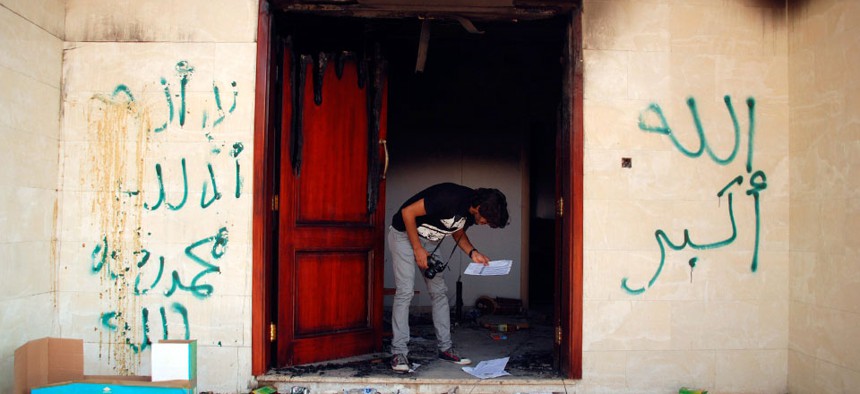
A man looks at documents at the U.S. consulate in Benghazi, Libya, after an attack that killed four Americans, Sept. 12, 2012. Ibrahim Alaguri/AP
Internal Benghazi Report Details State Department Security Flaws
Risk assessments of embassies and consulates in dangerous areas are determined by 'experience and intuition.'
So, remember the (small) part of the Benghazi conspiracy theory where "they" ignored repeated warnings of security failures at the high-risk facility in Libya? Well, it turns out that, according to an internal government report, the State Department failed to address a series of security issues at America's most vulnerable embassies for decades. But conservative Benghazi theorists who'd like to take the major scoop and run with it will face some cognitive dissonance: the documents were obtained by Al Jazeera America.
The report is a result of a recommendation by the State Department's Accountability Review Board investigation into the Benghazi attacks. That report also found security failures by the State Department in the case of Benghazi. The internal panel, whose report is cited by Al Jazeera America, was chaired by former U.S. Secret Service Director Mark Sullivan. That report, which mentions 273 "significant attacks" on U.S. diplomatic facilities between 1998 and 2012, concluded:
- The State Department has an endemic lack of accountability on security issues. AJA explains:
The undersecretary for management oversees security issues while also handling many other responsibilities. A newly created undersecretary for diplomatic security would allow the State Department to better focus on security issues affecting diplomatic posts around the world.
- There's a serious lack of review processes for the bureau responsible for embassy security:
The Bureau of Diplomatic Security, the State Department security arm created following the 1983 bombings of the U.S. Embassy and Marine barracks in Beirut, does not have a review process in place to learn from previous security failures.
- The survivors of Benghazi were never debriefed.
- Risk assessments of embassies and consulates in dangerous areas are determined by "experience and intuition." At least some high-risk facilities lack an intelligence analyst on-site, and there's no designated facility to train agents entering high-risk posts.






